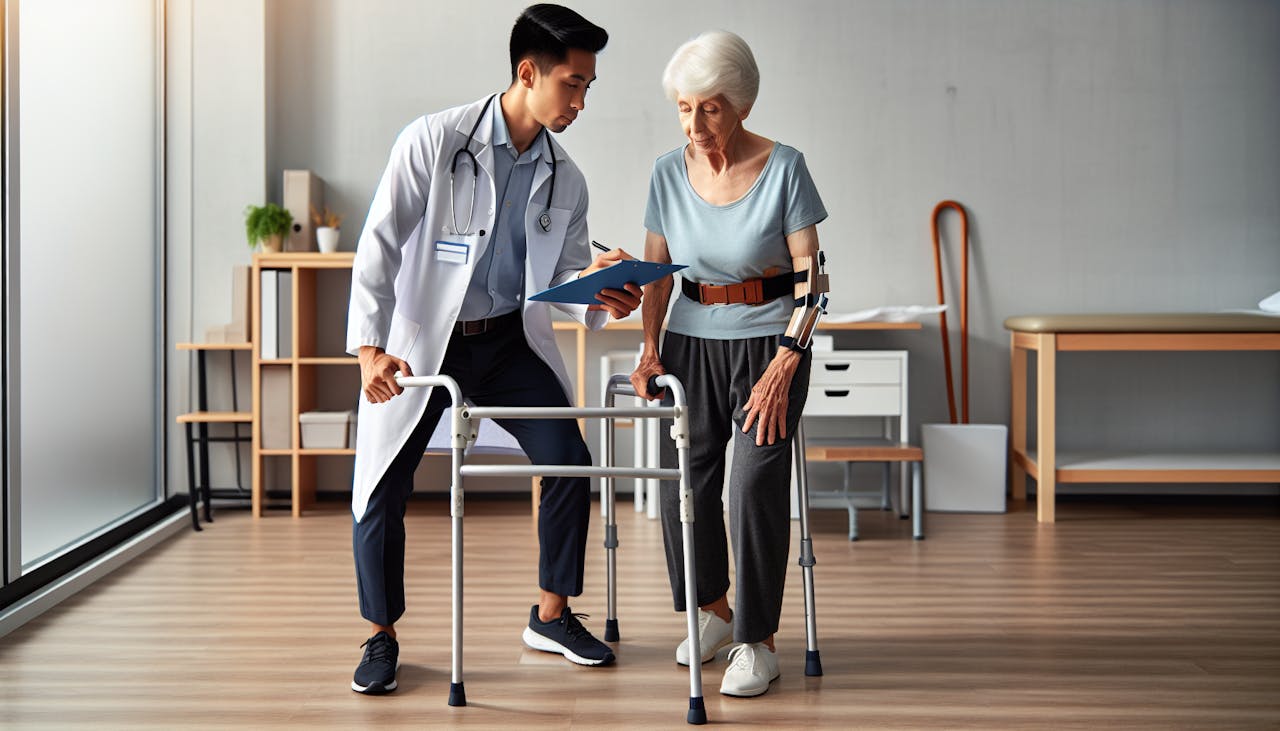The Key Role of EMS in Assessing Elderly Mobility
Unlocking mobility assessment in the elderly with EMS! Discover the power of this tool in improving quality of life.

Understanding Mobility Assessment Tools
When it comes to assessing mobility in the elderly population, there is a need for reliable and valid assessment tools. These tools play a crucial role in evaluating and monitoring the mobility levels of older individuals, facilitating appropriate interventions and improving their quality of life.
Importance of Mobility Assessment
Mobility assessment is essential for understanding an individual's ability to move and navigate their environment. It helps healthcare professionals identify mobility limitations, predict functional decline, and develop targeted interventions to improve mobility and independence. Assessing mobility is particularly important for the elderly population, as age-related changes and underlying health conditions can impact their ability to move safely and efficiently.

Accurate mobility assessment provides valuable information for healthcare professionals to develop personalized care plans, optimize rehabilitation strategies, and measure the effectiveness of interventions over time. It enables them to identify mobility deficits, track progress, and make informed decisions regarding mobility aids or assistive devices.
Existing Mobility Assessment Instruments
Several mobility assessment instruments have been developed to measure and monitor mobility in older individuals. Three commonly used instruments are the Elderly Mobility Scale (EMS), the Hierarchical Assessment of Balance and Mobility (HABAM), and the Physical Performance Mobility Examination (PPME).

Each of these assessment instruments offers unique features and focuses on different aspects of mobility. However, it is important to note that no existing instrument has all the properties required to accurately measure and monitor changes in mobility for older acute medical patients. Further research and the development of new mobility assessment tools are necessary to meet the specific needs of this population and improve their overall care.
The Elderly Mobility Scale (EMS)
The Elderly Mobility Scale (EMS) is a standardized assessment tool designed to measure mobility and functional abilities in elderly individuals. It consists of tasks that evaluate a person's ability to perform various movements such as sitting, standing, walking, and climbing stairs. The scale assigns a score to each task, which is used to determine the individual's overall mobility level [2].
Overview of EMS
The EMS provides healthcare professionals with a comprehensive understanding of an older adult's mobility limitations and functional abilities. By utilizing this scale, they can develop appropriate care plans, identify areas for improvement, and monitor changes in mobility over time. The EMS assessment includes tasks that assess different aspects of mobility, such as balance, strength, and coordination. Each task is scored on a scale, and the scores are combined to determine the overall mobility level of the individual.
Validity and Reliability of EMS
Validity is an essential aspect of any assessment tool, including the EMS. It refers to the extent to which the scale measures mobility in the elderly population accurately. Validity ensures that the EMS is measuring the intended construct and not something else. The EMS has been subject to studies to evaluate its validity, including the development of the Italian version of the Elderly Mobility Scale (I-EMS). The validity of the I-EMS was supported by a significant correlation with the Barthel Index, which measures activities of daily living.
Reliability is another critical aspect of assessment tools. It concerns the consistency and stability of the EMS in measuring mobility in elderly individuals. A reliable scale should provide consistent scores for the same individual when administered under similar conditions. The reliability of the I-EMS was evaluated through inter-rater reliability testing. The study found no statistically significant differences between the scores assigned by different raters, indicating good reliability. The Intraclass Correlation Coefficient (ICC) for the total I-EMS was 0.951, indicating a high level of agreement between raters.
Clinical Utility of EMS
The EMS has proven to be a valuable tool in clinical settings. Its ease of use and relatively short administration time make it suitable for routine clinical assessment. The information obtained from the EMS assessment helps healthcare professionals in developing individualized care plans and interventions for elderly individuals. It allows for targeted interventions to improve mobility and functional abilities, ultimately aiming to enhance the quality of life for older adults.
Comparison with Other Instruments
When it comes to assessing mobility in the elderly, various instruments are available for healthcare professionals to choose from. In this section, we will compare the Elderly Mobility Scale (EMS) with two other commonly used instruments: Hierarchical Assessment of Balance and Mobility (HABAM) and Physical Performance Mobility Examination (PPME).
Hierarchical Assessment of Balance and Mobility (HABAM)
The HABAM is a widely used instrument for assessing mobility in older adults. It provides interval level data and is known for its desirable properties, making it an effective tool in measuring mobility. However, it should be noted that the HABAM has a ceiling effect in older acute medical patient populations, meaning that it may not accurately reflect the mobility of individuals with higher levels of mobility impairment. Reliability and minimally clinically important difference (MCID) estimates have not been reported for the Rasch refined HABAM.
Physical Performance Mobility Examination (PPME)
The PPME is another instrument commonly used to assess mobility in older adults. One of the advantages of the PPME is that it has no floor or ceiling effects, meaning that it can accurately measure mobility across a wide range of abilities [4]. It has been reported to be quick and easy to administer, making it a feasible option for measuring mobility in older medical patients [4]. Unlike the EMS and HABAM, the PPME does not have the limitations of a ceiling effect, allowing for a more accurate assessment of mobility in individuals with higher levels of mobility impairment.
Limitations and Advantages
Each instrument has its own limitations and advantages. While the EMS has been found to have a ceiling effect in older acute medical patient populations. On the other hand, the PPME offers a quick and easy administration process with no floor or ceiling effects, allowing for a more comprehensive assessment of mobility.
When selecting an instrument for assessing mobility in the elderly, healthcare professionals should consider the specific needs of their patients and the limitations and advantages of each instrument. The choice of instrument should align with the clinical context and the desired outcomes of the assessment.
Case Studies and Research Findings
In order to understand the effectiveness and usefulness of the Elderly Mobility Scale (EMS) in assessing mobility in the elderly population, several studies have been conducted. These studies shed light on the benefits and limitations of using EMS as a mobility assessment tool.
Studies on EMS and Mobility
Research studies have demonstrated the value of the EMS in evaluating mobility in elderly individuals. For example, a study of 83 patients with a mean age of 79 in a clinical day hospital found that the EMS was significantly more likely to detect an improvement in mobility following a course of physiotherapy compared to two other functional measures. This highlights the sensitivity and effectiveness of the EMS in assessing changes in mobility over time.
Use of EMS in Clinical Settings
The EMS has been widely utilized in clinical settings to assess mobility in older adults. Its ease of use and relatively short administration time make it suitable for routine clinical assessment. Clinicians can administer the EMS to gain insights into an individual's mobility capabilities and track changes over time, allowing for better treatment planning and intervention strategies.
However, it is worth noting that the EMS has a ceiling effect in certain populations, such as older acute medical patients. Approximately one-quarter of patients in this population score the maximum possible score on the EMS, which may limit its ability to detect subtle changes in mobility. Despite this limitation, the EMS remains a valuable tool for evaluating mobility in a wide range of clinical settings.
Modified Elderly Mobility Scale (MEMS)
To address the ceiling effect observed in the EMS, researchers have developed modifications to enhance its sensitivity. The Modified Elderly Mobility Scale (MEMS) takes into account additional factors such as balance, transfers, and gait speed. By incorporating these factors, the MEMS aims to provide a more comprehensive assessment of mobility in the elderly population.
The MEMS has shown promise in its ability to detect changes in mobility that might not be captured by the EMS alone. Its use may be beneficial in populations where the EMS reaches its ceiling effect, allowing for a more nuanced evaluation of mobility.
By considering the findings from various studies and the use of EMS in clinical settings, it becomes evident that the EMS is a valuable tool for assessing mobility in elderly individuals. However, it is important to recognize the limitations of the scale and consider modifications like the MEMS when necessary. These assessment tools provide clinicians with valuable insights into the mobility status of their patients, assisting in the development of appropriate interventions to improve the quality of life for older adults.
Extending Mobility Assessment
As the field of mobility assessment continues to evolve, researchers and healthcare professionals have developed extensions to existing tools to enhance accuracy and address limitations. Two notable extensions are the John Hopkins Highest Level of Mobility (JH-HLM) and the AMsterdam UMC EXtension of the JOhn HOpkins Highest Level of mObility (AMEXO).
John Hopkins Highest Level of Mobility (JH-HLM)
The John Hopkins Highest Level of Mobility (JH-HLM) scale is widely used to assess mobilization after surgeries, but it has been associated with a ceiling effect. According to a study published in PubMed Central, 45.2% of patients scored the highest possible mobility score on the first postoperative day when using the JH-HLM scale.
AMsterdam UMC EXtension of the JOhn HOpkins Highest Level of mObility (AMEXO)
To address the ceiling effect observed with the JH-HLM scale, an extension called the AMsterdam UMC EXtension of the JOhn HOpkins Highest Level of mObility (AMEXO) was developed. This extension significantly reduced the ceiling effect, with only 1.7% of patients scoring the highest possible mobility score on the first postoperative day after the extension.
The AMEXO scale introduced additional response categories to provide a more comprehensive assessment of mobility. Before the extension, 87.4% of patients scored the highest possible mobility score on one of the first three postoperative days. However, after the extension, only 16.8% of patients achieved the highest possible mobility score during the same period.
The extension also revealed a higher rate of change in mobility scores. After the extension, 94.5% of patients showed a change in mobility score during the first three postoperative days, compared to 65.2% before the extension. Furthermore, 73.3% of patients who exhibited a change in mobility score after the extension also scored a response category of 9 to 12 on the AMEXO scale during one of the first three postoperative days.
Impact on Assessment Accuracy
The extension of the JH-HLM scale to the AMEXO scale has had a significant impact on assessment accuracy. By reducing the ceiling effect and introducing additional response categories, the AMEXO scale provides a more nuanced evaluation of mobility in the postoperative period. This extension allows healthcare professionals to better track changes in mobility and identify subtle improvements or declines.
The development of extensions like AMEXO highlights the ongoing efforts to refine and improve mobility assessment tools. By continually adapting and extending existing instruments, healthcare professionals can ensure more accurate and comprehensive assessments of elderly mobility, leading to better care and improved quality of life.
References
- https://hqlo.biomedcentral.com/articles/10.1186/1477-7525-6-44
- https://www.nautilusshc.com/blog/elderly-mobility-scale/
- https://www.ncbi.nlm.nih.gov/pmc/articles/PMC10684775/
- https://www.ncbi.nlm.nih.gov/pmc/articles/PMC2430553/
- https://www.physio-pedia.com/ElderlyMobilityScale
- https://www.ncbi.nlm.nih.gov/pmc/articles/PMC8812167/




















